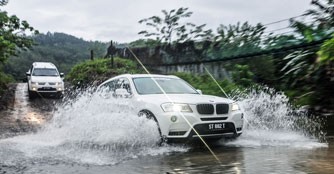What makes the BMW's xDrive system that good?
01 Nov 2012|11,317 views
It's a Tuesday morning on the rough terrains in Kota Kinabalu. All buckled up, I place my feet on the gas pedal as I prepare myself in anticipation for the car to go through the rumbled up tarmac before having to go through a deep and huge puddle of water. Once the signal is given, I step on the gas, sending the car out into the wild as it scuffled through with much poise and confidence.

Shown from the comprehensive video above, the xDrive system splits drive variably to the front and rear axles to suit the driving situation and the surface. Under normal circumstances, it distributes driver power between the front and rear axles in a 40:60 ratio, and changes this figure variably when the road surface or overall driving conditions change.
Acting almost instantaneously and in a manner so subtle, the xDrive system operates virtually unnoticed by the vehicle's passengers and can direct up to 100% of drive forces to one axle. Enabling the driver to start up effortlessly even on slippery surfaces or steep hills, the xDrive system routes all power to the axles with the greatest traction. When parking, the system reacts to the need for high manoeuvrability at low speed by opening the clutch completely so the powertrain functions optimally.

Driving on a winding road or taking a fast bend in dynamic style is particularly enjoyable with the BMW xDrive: the driver feels as if the vehicle is being guided along the curve. The xDrive system ensures that no drive power is wasted on a loss of traction, and that every kilowatt of power is effectively used on the road.
Unlike conventional all-wheel drive systems that are widely used in the industry today to make up for the shortfall in traction suffered by front-wheel-drive vehicles, BMW tunes its xDrive system to provide handling typical of rear-wheel drive. Even in normal situations on the road, all-wheel-drive BMW models send the majority of the drive to the rear wheels.
It's a Tuesday morning on the rough terrains in Kota Kinabalu. All buckled up, I place my feet on the gas pedal as I prepare myself in anticipation for the car to go through the rumbled up tarmac before having to go through a deep and huge puddle of water. Once the signal is given, I step on the gas, sending the car out into the wild as it scuffled through with much poise and confidence.

Shown from the comprehensive video above, the xDrive system splits drive variably to the front and rear axles to suit the driving situation and the surface. Under normal circumstances, it distributes driver power between the front and rear axles in a 40:60 ratio, and changes this figure variably when the road surface or overall driving conditions change.
Acting almost instantaneously and in a manner so subtle, the xDrive system operates virtually unnoticed by the vehicle's passengers and can direct up to 100% of drive forces to one axle. Enabling the driver to start up effortlessly even on slippery surfaces or steep hills, the xDrive system routes all power to the axles with the greatest traction. When parking, the system reacts to the need for high manoeuvrability at low speed by opening the clutch completely so the powertrain functions optimally.

Driving on a winding road or taking a fast bend in dynamic style is particularly enjoyable with the BMW xDrive: the driver feels as if the vehicle is being guided along the curve. The xDrive system ensures that no drive power is wasted on a loss of traction, and that every kilowatt of power is effectively used on the road.
Unlike conventional all-wheel drive systems that are widely used in the industry today to make up for the shortfall in traction suffered by front-wheel-drive vehicles, BMW tunes its xDrive system to provide handling typical of rear-wheel drive. Even in normal situations on the road, all-wheel-drive BMW models send the majority of the drive to the rear wheels.
Thank You For Your Subscription.





























































